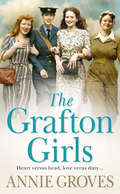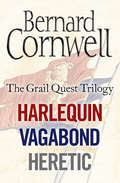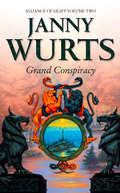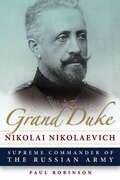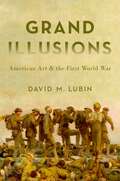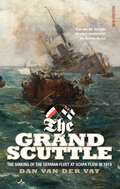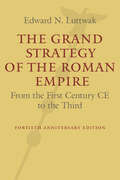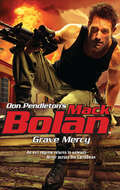- Table View
- List View
The Governors-General: The English Army and the Definition of the Empire, 1569-1681 (Published by the Omohundro Institute of Early American History and Culture and the University of North Carolina Press)
by Stephen Saunders WebbIn this remarkable revisionist study, Webb shows that English imperial policy was shaped by a powerful and sustained militaristic, autocratic tradition that openly defined English empire as the imposition of state control by force on dependent people. He describes the entire military connection that found expression in the garrisoned cities of England, Scotland, and Ireland and ultimately in the palisaded plantations of Jamaica, Virginia, and New England.Originally published in 1987.A UNC Press Enduring Edition -- UNC Press Enduring Editions use the latest in digital technology to make available again books from our distinguished backlist that were previously out of print. These editions are published unaltered from the original, and are presented in affordable paperback formats, bringing readers both historical and cultural value.
Grace O'Malley: The Biography of Ireland's Pirate Queen 1530–1603 with a Forward by Mary McAleese
by Anne ChambersGrace O’Malley is unique as the only woman recorded on the famous Baptista Boazio map of Ireland (1599), a tribute to the status she achieved as a leader on land and at sea in the 16th century. In 1979 Anne Chambers’ original biography of this famous Irishwoman, who over the centuries had been airbrushed from historical record, put her on the map once again. The biography became a milestone in Irish publishing and the catalyst for the restoration of Grace O’Malley to political, social and maritime history, as well as establishing her as an inspirational female role model in the classroom.In the 40th anniversary edition of this international bestselling biography, drawn from rare contemporary manuscript records, the author presents Ireland’s great pirate queen not as a vague mythological figure but as one of the world’s most extraordinary female leaders. Political pragmatist and tactician, rebel, intrepid mariner and pirate, wife, lover, mother, grandmother and matriarch, the ‘most notorious woman in all the coasts of Ireland’, Grace O’Malley challenged and triumphed over the social and political barriers she encountered in the course of her long, pioneering life.Breaching boundaries of gender imbalance and bias in a period of immense social and political upheaval and change, Grace O’Malley rewrote the rules to become one of the world’s first recorded feminist trailblazers.This updated anniversary edition brings Grace O’Malley’s story to a new generation awakened to the global focus on gender equality as well as positive ageing.
The Grafton Girls
by Annie GrovesThe new Liverpool-based World War Two saga from the author of Goodnight Sweetheart is a tale of four very different young women thrown together by war. A unique bond is formed as the hostilities take their toll on Britain.
The Grail Quest Books 1-3: Harlequin, Vagabond, Heretic
by Bernard CornwellBernard Cornwell’s bestselling Grail Quest Trilogy in one complete eBook for the first time. Follow the famed archer Thomas of Hookton as he avenges his father’s death and retrieves a stolen relic.
The Grand Alliance and Ukrainian Refugees (St Antony's Series)
by M. DyczokThis study explores the role of refugees in international relations by looking at the largest involuntary migration of Ukrainians in history. Using both Western and newly available Soviet sources it sheds light on Grand Alliance policies towards World War II Ukrainian refugees. It demonstrates how the activities of this particular group of refugees had an impact on international refugee policy and provides insight into the origins of the Cold War.
The Grand Chessboard: American Primacy and Its Geostrategic Imperatives
by Zbigniew BrzezinskiBestselling author and eminent foreign policy scholar Zbigniew Brzezinski's classic book on American's strategic mission in the modern world.In The Grand Chessboard, renowned geostrategist Zbigniew Brzezinski delivers a brutally honest and provocative vision for American preeminence in the twenty-first century. The task facing the United States, he argues, is to become the sole political arbiter in Eurasian lands and to prevent the emergence of any rival power threatening our material and diplomatic interests. The Eurasian landmass, home to the greatest part of the globe's population, natural resources, and economic activity, is the "grand chessboard" on which America's supremacy will be ratified and challenged in the years to come. In this landmark work of public policy and political science, Brzezinski outlines a groundbreaking and powerful blueprint for America's vital interests in the modern world.In this revised edition, Brzezinski addresses recent global developments including the war in Ukraine, the re-emergence of Russia, and the rise of China.
Grand Conspiracy: Second Book of The Alliance of Light (The Wars of Light and Shadow #5)
by Janny WurtsWhere there is light, there must always be shadow… The fifth volume in Janny Wurts’s spectacular epic fantasy, now re-released with a striking new cover design along with the rest of the series.
The Grand Design: The Evolution of the International Peace Architecture
by Oliver P. RichmondThe guiding principle of peacemaking and peacebuilding over the past quarter century has been "liberal peace": the promotion of democracy, capitalism, law, and respect for human rights. These components represent a historic effort to prevent a reoccurrence of the nationalism, fascism, and economic collapse that led to the World Wars as well as many later conflicts. Ultimately, this strategy has been somewhat successful in reducing war between countries, but it has failed to produce legitimate and sustainable forms of peace at the domestic level. The goals of peacebuilding have changed over time and place, but they have always been built around compromise via processes of intervention aimed at supporting "progress" in conflict-affected countries. They have simultaneously promoted changes in the regional and global order. As Oliver P. Richmond argues in this book, the concept of peace has evolved continuously through several eras: from the imperial era, through the states-system, liberal, and current neoliberal eras of states and markets. It holds the prospect of developing further through the emerging "digital" era of transnational networks, new technologies, and heightened mobility. Yet, as recent studies have shown, only a minority of modern peace agreements survive for more than a few years and many peace agreements and peacebuilding missions have become intractable, blocked, or frozen. This casts a shadow on the legitimacy, stability, and effectiveness of the overall international peace architecture, reflecting significant problems in the evolution of an often violently contested international and domestic order. This book examines the development of the international peace architecture, a "grand design" comprising various subsequent attempts to develop a peaceful international order. Richmond examines six main theoretical-historical stages in this process often addressed through peacekeeping and international mediation, including the balance of power mechanism of the 19th Century, liberal internationalism after World War I, and the expansion of rights and decolonization after World War II. It also includes liberal peacebuilding after the end of the Cold War, neoliberal statebuilding during the 2000s, and an as yet unresolved current "digital" stage. They have produced a substantial, though fragile, international peace architecture. However, it is always entangled with, and hindered by, blockages and a more substantial counter-peace framework. The Grand Design provides a sweeping look at the troubled history of peace processes, peacemaking, peacekeeping, and peacebuilding, and their effects on the evolution of international order. It also considers what the next stage may bring.
The Grand Design: The Evolution of the International Peace Architecture
by Oliver P. RichmondThe guiding principle of peacemaking and peacebuilding over the past quarter century has been "liberal peace": the promotion of democracy, capitalism, law, and respect for human rights. These components represent a historic effort to prevent a reoccurrence of the nationalism, fascism, and economic collapse that led to the World Wars as well as many later conflicts. Ultimately, this strategy has been somewhat successful in reducing war between countries, but it has failed to produce legitimate and sustainable forms of peace at the domestic level. The goals of peacebuilding have changed over time and place, but they have always been built around compromise via processes of intervention aimed at supporting "progress" in conflict-affected countries. They have simultaneously promoted changes in the regional and global order. As Oliver P. Richmond argues in this book, the concept of peace has evolved continuously through several eras: from the imperial era, through the states-system, liberal, and current neoliberal eras of states and markets. It holds the prospect of developing further through the emerging "digital" era of transnational networks, new technologies, and heightened mobility. Yet, as recent studies have shown, only a minority of modern peace agreements survive for more than a few years and many peace agreements and peacebuilding missions have become intractable, blocked, or frozen. This casts a shadow on the legitimacy, stability, and effectiveness of the overall international peace architecture, reflecting significant problems in the evolution of an often violently contested international and domestic order. This book examines the development of the international peace architecture, a "grand design" comprising various subsequent attempts to develop a peaceful international order. Richmond examines six main theoretical-historical stages in this process often addressed through peacekeeping and international mediation, including the balance of power mechanism of the 19th Century, liberal internationalism after World War I, and the expansion of rights and decolonization after World War II. It also includes liberal peacebuilding after the end of the Cold War, neoliberal statebuilding during the 2000s, and an as yet unresolved current "digital" stage. They have produced a substantial, though fragile, international peace architecture. However, it is always entangled with, and hindered by, blockages and a more substantial counter-peace framework. The Grand Design provides a sweeping look at the troubled history of peace processes, peacemaking, peacekeeping, and peacebuilding, and their effects on the evolution of international order. It also considers what the next stage may bring.
Grand Duke Nikolai Nikolaevich: Supreme Commander of the Russian Army (NIU Series in Slavic, East European, and Eurasian Studies)
by Paul RobinsonGrand Duke Nikolai Nikolaevich Romanov (1856–1929) was a key figure in late Imperial Russia, and one of its foremost soldiers. At the outbreak of World War I, his cousin, Tsar Nicholas II, appointed him Supreme Commander of the Russian Army. From 1914 to 1915, and then again briefly in 1917, he was commander of the largest army in the world in the greatest war the world had ever seen. His appointment reflected the fact that he was perhaps the man the last Emperor of Russia trusted the most. At six foot six, the Grand Duke towered over those around him. His fierce temper was a matter of legend. However, as Robinson's vivid account shows, he had a more complex personality than either his supporters or detractors believed. In a career spanning fifty years, the Grand Duke played a vital role in transforming Russia's political system. In 1905, the Tsar assigned him the duty of coordinating defense and security planning for the entire Russian empire. When the Tsar asked him to assume the mantle of military dictator, the Grand Duke, instead of accepting, persuaded the Tsar to sign a manifesto promising political reforms. Less opportunely, he also had a role in introducing the Tsar and Tsarina to the infamous Rasputin. A few years after the revolution in 1917, the Grand Duke became de facto leader of the Russian émigré community. Despite his importance, the only other biography of the Grand Duke was written by one of his former generals in 1930, a year after his death, and it is only available in Russian. The result of research in the archives of seven countries, this groundbreaking biography—the first to appear in English—covers the Grand Duke's entire life, examining both his private life and his professional career. Paul Robinson's engaging account will be of great value to those interested in World War I and military history, Russian history, and biographies of notable figures.
The Grand Fleet 1914-19: The Royal Navy in the First World War
by Daniel George Ridley-KittsThe First World War was the first real time in 100 years that the reputation of the British Royal Navy was put on the line in defence of the country. This book tells of the creation and development of the Grand Fleet under the drive of the energetic and charismatic admiral of the fleet ‘Jacky’ Fisher, who modernised the navy with the introduction of the revolutionary Dreadnought battleship. This type of vessel in particular made other nations’ battleships obsolete, created a powerful weapon for the defence of Empire and trade, and finally defeated the designs of Kaiser William III. Using unique technical drawings rendered by the author, the history of the Grand Fleet is told in accessible narrative style, with outstanding technical detail which will satisfy naval enthusiasts.
Grand Illusions: American Art and the First World War
by David M. LubinA vivid, engaging account of the artists and artworks that sought to make sense of America's first total war, Grand Illusions takes readers on a compelling journey through the major historical events leading up to and beyond US involvement in WWI to discover the vast and pervasive influence of the conflict on American visual culture. David M. Lubin presents a highly original examination of the era's fine arts and entertainment to show how they ranged from patriotic idealism to profound disillusionment. In stylishly written chapters, Lubin assesses the war's impact on two dozen painters, designers, photographers, and filmmakers from 1914 to 1933. He considers well-known figures such as Marcel Duchamp, John Singer Sargent, D. W. Griffith, and the African American outsider artist Horace Pippin while resurrecting forgotten artists such as the mask-maker Anna Coleman Ladd, the sculptor Gertrude Vanderbilt Whitney, and the combat artist Claggett Wilson. The book is liberally furnished with illustrations from epoch-defining posters, paintings, photographs, and films. Armed with rich cultural-historical details and an interdisciplinary narrative approach, David Lubin creatively upends traditional understandings of the Great War's effects on the visual arts in America.
Grand Illusions: American Art and the First World War
by David M. LubinA vivid, engaging account of the artists and artworks that sought to make sense of America's first total war, Grand Illusions takes readers on a compelling journey through the major historical events leading up to and beyond US involvement in WWI to discover the vast and pervasive influence of the conflict on American visual culture. David M. Lubin presents a highly original examination of the era's fine arts and entertainment to show how they ranged from patriotic idealism to profound disillusionment. In stylishly written chapters, Lubin assesses the war's impact on two dozen painters, designers, photographers, and filmmakers from 1914 to 1933. He considers well-known figures such as Marcel Duchamp, John Singer Sargent, D. W. Griffith, and the African American outsider artist Horace Pippin while resurrecting forgotten artists such as the mask-maker Anna Coleman Ladd, the sculptor Gertrude Vanderbilt Whitney, and the combat artist Claggett Wilson. The book is liberally furnished with illustrations from epoch-defining posters, paintings, photographs, and films. Armed with rich cultural-historical details and an interdisciplinary narrative approach, David Lubin creatively upends traditional understandings of the Great War's effects on the visual arts in America.
The Grand Scuttle: The Sinking of the German Fleet at Scapa Flow in 1919 (A\format Ser.)
by Dan Van Der VatAt Scapa Flow on 21 June 1919, there occurred an event unique in naval history. The German High Seas Fleet, one of the most formidable ever built, was deliberately sent to the bottom of the British Grand Fleet's principal anchorage at Orkney by its own officers and men. This book presents the story of the scuttling of this fleet in Scapa Flow.
Grand Strategy in the War Against Terrorism
by Thomas R. Mockaitis Paul B. RichThis collection of essays examines the strategic dimensions of contemporary terrorist threats. It evaluates the changing nature of modern terrorism in the light of the events of September 11 2001. The collection argues that terrorism now promises to enter the terrain of global "grand strategy".
Grand Strategy in the War Against Terrorism
by Thomas R. Mockaitis Paul B. RichThis collection of essays examines the strategic dimensions of contemporary terrorist threats. It evaluates the changing nature of modern terrorism in the light of the events of September 11 2001. The collection argues that terrorism now promises to enter the terrain of global "grand strategy".
The Grand Strategy of Classical Sparta: The Persian Challenge (Yale Library of Military History)
by Paul Anthony RaheMore than 2500 years ago a confederation of small Greek city-states defeated the invading armies of Persia, the most powerful empire in the world. In this meticulously researched study, historian Paul Rahe argues that Sparta was responsible for the initial establishment of the Hellenic defensive coalition and was, in fact, the most essential player in its ultimate victory. Drawing from an impressive range of ancient sources, including Herodotus and Plutarch, the author veers from the traditional Atheno-centric view of the Greco-Persian Wars to examine from a Spartan perspective the grand strategy that halted the Persian juggernaut. Rahe provides a fascinating, detailed picture of life in Sparta circa 480 B.C., revealing how the Spartans’ form of government and the regimen to which they subjected themselves instilled within them the pride, confidence, discipline, and discernment necessary to forge an alliance that would stand firm against a great empire, driven by religious fervor, that held sway over two-fifths of the human race.
The Grand Strategy of the Habsburg Empire
by A. MitchellThe Habsburg Empire’s grand strategy for outmaneuvering and outlasting stronger rivals in a complicated geopolitical worldThe Empire of Habsburg Austria faced more enemies than any other European great power. Flanked on four sides by rivals, it possessed few of the advantages that explain successful empires. Its army was not renowned for offensive prowess, its finances were often shaky, and its populace was fragmented into more than a dozen ethnicities. Yet somehow Austria endured, outlasting Ottoman sieges, Frederick the Great, and Napoleon. The Grand Strategy of the Habsburg Empire tells the story of how this cash-strapped, polyglot empire survived for centuries in Europe's most dangerous neighborhood without succumbing to the pressures of multisided warfare.Taking readers from the War of the Spanish Succession in the early 1700s to the Austro-Prussian War of 1866, A. Wess Mitchell argues that the Habsburgs succeeded not through offensive military power or great wealth but by developing strategies that manipulated the element of time in geopolitical competition. Unable to fight all their enemies at once, the Habsburgs learned to use the limited tools at their disposal—terrain, technology, and treaty allies—to sequence and stagger their conflicts, drive down the costs of empire, and concentrate scarce resources against the greatest threat of the moment. Rarely holding a grudge after war, they played the "long game" in geopolitics, corralling friend and foe alike into voluntarily managing the empire's lengthy frontiers and extending a benign hegemony across the turbulent lands of middle Europe.A study in adaptive statecraft, The Grand Strategy of the Habsburg Empire offers lessons on how to navigate a messy geopolitical map, stand firm without the advantage of military predominance, and prevail against multiple rivals.
The Grand Strategy of the Roman Empire: From the First Century CE to the Third
by Edward N. LuttwakAt the height of its power, the Roman Empire encompassed the entire Mediterranean basin, extending much beyond it from Britain to Mesopotamia, from the Rhine to the Black Sea. Rome prospered for centuries while successfully resisting attack, fending off everything from overnight robbery raids to full-scale invasion attempts by entire nations on the move. How were troops able to defend the Empire;€™s vast territories from constant attacks? And how did they do so at such moderate cost that their treasury could pay for an immensity of highways, aqueducts, amphitheaters, city baths, and magnificent temples? In The Grand Strategy of the Roman Empire, seasoned defense analyst Edward N. Luttwak reveals how the Romans were able to combine military strength, diplomacy, and fortifications to effectively respond to changing threats. Rome;€™s secret was not ceaseless fighting, but comprehensive strategies that unified force, diplomacy, and an immense infrastructure of roads, forts, walls, and barriers. Initially relying on client states to buffer attacks, Rome moved to a permanent frontier defense around 117 CE. Finally, as barbarians began to penetrate the empire, Rome filed large armies in a strategy of "defense-in-depth," allowing invaders to pierce Rome;€™s borders. This updated edition has been extensively revised to incorporate recent scholarship and archeological findings. A new preface explores Roman imperial statecraft. This illuminating book remains essential to both ancient historians and students of modern strategy.
The Grand Strategy of the Roman Empire: From the First Century CE to the Third
by Edward N. LuttwakAt the height of its power, the Roman Empire encompassed the entire Mediterranean basin, extending much beyond it from Britain to Mesopotamia, from the Rhine to the Black Sea. Rome prospered for centuries while successfully resisting attack, fending off everything from overnight robbery raids to full-scale invasion attempts by entire nations on the move. How were troops able to defend the Empire;€™s vast territories from constant attacks? And how did they do so at such moderate cost that their treasury could pay for an immensity of highways, aqueducts, amphitheaters, city baths, and magnificent temples? In The Grand Strategy of the Roman Empire, seasoned defense analyst Edward N. Luttwak reveals how the Romans were able to combine military strength, diplomacy, and fortifications to effectively respond to changing threats. Rome;€™s secret was not ceaseless fighting, but comprehensive strategies that unified force, diplomacy, and an immense infrastructure of roads, forts, walls, and barriers. Initially relying on client states to buffer attacks, Rome moved to a permanent frontier defense around 117 CE. Finally, as barbarians began to penetrate the empire, Rome filed large armies in a strategy of "defense-in-depth," allowing invaders to pierce Rome;€™s borders. This updated edition has been extensively revised to incorporate recent scholarship and archeological findings. A new preface explores Roman imperial statecraft. This illuminating book remains essential to both ancient historians and students of modern strategy.
A Grandstand Seat: The American Balloon Service in World War I (Non-ser.)
by Eileen LebowThe little-known American Balloon Service worked in combat to help direct artillery fire more accurately and provide essential intelligence on enemy troop movements during World War I. German use of observation balloons to direct artillery fire in August of 1914 forced the Allies to develop a similar force. With the U.S. entry into the war in 1917, the balloon service, starting from scratch, evolved into an effective, disciplined fighting unit, whose achievements are unfortunately overshadowed by those of the flying aces. Reminiscences from balloon veterans form the basis of this book, the first to picture life as a gasbagger in the three major American engagements of the war.Amazingly, life as an observer suspended in a wicker basket under an elephantine hydrogen balloon proved less deadly than piloting an airplane. From his grandstand seat, the observer kept tabs on the war below him and telephoned vital information to headquarters command. These reports were often the only accurate intelligence available. Balloonists remember the war as a great adventure, one which many of them lived to tell about.
Grant
by Ron ChernowA dramatic portrait of one of America's most compelling generals and presidents, Ulysses S. Grant, by Pulitzer Prize winner Ron Chernow, author of the book on which the astonishing musical Hamilton is based. As late as April 1861, when the American Civil War broke out, Ulysses S. Grant was a dismal failure. A competent officer in the war against Mexico, he had resigned from the army over his drinking and had sunk into poverty as a civilian, losing all his money in hopeless investments. He had failed to secure the command of a volunteer unit and was about to return to his abject life working in his family's leather-goods store when he was offered the colonelcy of an Illinois regiment. Less than four years later he was the commanding general of the victorious Union armies and was hailed as a military genius. He later served two terms as President of the United States. This is the epic biography of a very unheroic American hero, a modest, reticent and principled man who surprised the world and changed it for the better.
Grass in Piccadilly
by Noel StreatfeildOnce fashionable and plush with flowers, post-war Mayfair has lost its dazzling charm. But that didn’t stop Charlotte Nettel and her husband Sir John from swapping life in the quiet northern countryside to convert their roomy Mayfair townhouse into flats.Their tenants come in all shapes and sizes – from pregnant couple Jack and Jenny to German migrants Paula and Heinrich – and they provide a constant stream of both entertainment and anxiety. But it’s Charlotte’s stepdaughter Penny, a disillusioned young women born into the uneasy interwar world, who proves to be the most difficult and scandalous tenant . . .Flashing between the lives of each tenant Carnegie Medal winning author Noel Streatfeild gives us a kaleidoscopic view of post-war London in her ingenious novel, Grass in Piccadilly. For fans of Muriel Spark’s A Far Cry From Kensington.
The Grasshopper's Run
by Siddhartha SarmaJust as the invasion begins, an ambitious and vicious Japanese officer orders the massacre of a village of the Ao Naga tribe. Among those killed is Uti, grandson of the eldest Ao chief.Gojen is his best friend, and on hearing the news of Uti's death he is unable to stay in school in Calcutta and so returns to the ancestral home, where he embarks on a gruelling journey of revenge.As the war unfolds and Gojen finds himself ever more embroiled in the battles and struggles for survival, it soon becomes clear that he is fighting for more than his homeland and the memory of his dead friend.
Grave Mercy
by Don PendletonThe horror of the Ton Ton Macoute has returned. At its helm, a mastermind of religious fanaticism and military strategy.


